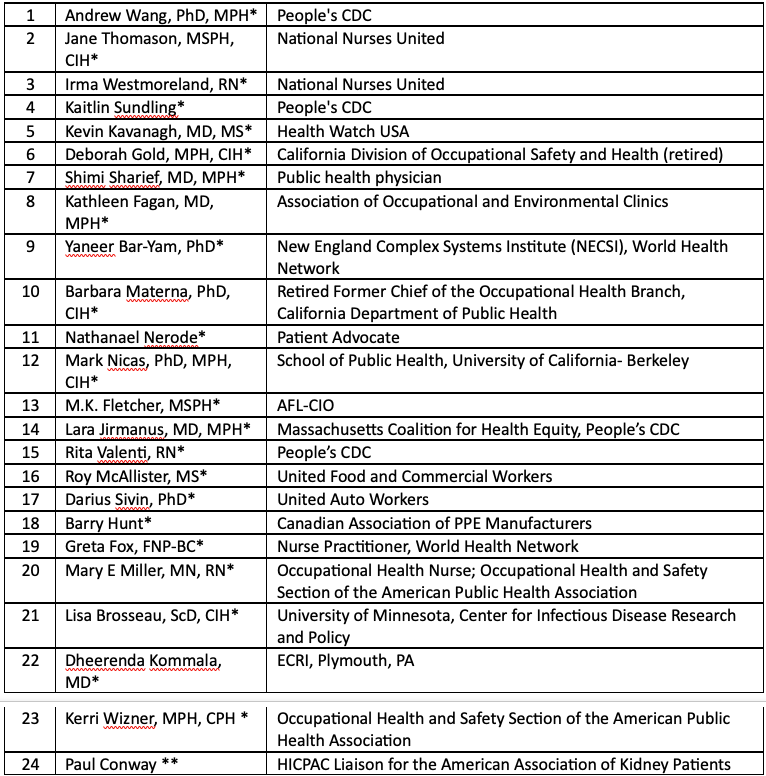As the White House maintains strict COVID-19 testing protocols for access to President Joseph Biden, protocols which recently detected SARS-CoV-2 in a member of the Israeli delegation, the CDC appears to be on the verge of relaxing infection disease strategies. During the CDC’s June 2023 Healthcare Infection Control Practices Advisory Committee (HICPAC) meeting, concerns were expressed regarding proposed updates to existing infection control guidance for health care facilities which would place patients, health care workers, and nursing home residents at risk.
The new proposals elicited many comments from prominent public health organizations, patient and worker safety organizations, labor unions, and other experts (Table 1). The CDC was complimented for updating recommendations, and there was uniform agreement that switching to a paradigm of air and touch transmission pathways, as opposed to droplet and airborne, was needed.
However, many proposals raised concern. Like the flawed Cochrane masking analysis, CDC/HICPAC analyzed studies were plagued with poor adherence and design issues and ignored other applicable research. One commentator stated that one cannot ethically design an optimal masking trial. The same is true for parachutes. One should refrain from throwing out decades of occupational research in favor of a few poorly implemented randomized controlled trials.
Table 1. HICPAC Commentators
HICPAC Commentators Included public (*) and HICPAC Liaison (**) commentators.
Videos of the CDC Presentation and Public Comments can be viewed at: https://bit.ly/44SDKwI
(To view larger, right-click the image, and click "open image in new tab." The image will show in a new tab.)
CDC/HICPAC is on the verge of adopting several problematic policies:
1. CDC/HICPAC proposes 3 levels of aerosol protection. Commentators disagreed with that approach because it maintains existing recommendations that reserve N95 respirators for only select pathogens (eg, measles, varicella) and “pandemic-phase” pathogens (eg, influenza, coronaviruses) and recommends a surgical mask for other respiratory viruses, including “seasonal” influenza and coronaviruses. Different tiers of protection between pandemic and seasonal phases for the same pathogens are arbitrary and ignore decades of research. Proposals also weaken protections for novel viruses. Negative pressure rooms were not recommended for MERS, SARS-CoV-1, SARS-CoV-2, or novel pathogens.
2. CDC/HICPAC proposes Enhanced Barrier Precautions (EBPs) for nursing homes where barrier precautions are only recommended for staff-patient interactions with high transmission risk. EBPs are not supported by the predicate research,which found that some low-risk activities, such as passing meds, are performed so commonly that staff clothing contamination would occur. Additionally, residents under EBPs can still participate in normal facility activities. Disturbingly these recommendations are being advocated to control Candida auris and Carbapenem-resistant Enterobacteriaceae transmission.
3. Overall, there was a concern that the CDC/HICPAC continued to propagate watered-down crisis standards by proposing only a minimal standard for infection control programs. This crisis-standards approach during the COVID-19 pandemic led to extensive health care worker and patient infections, though tracking of both has been woefully insufficient in the US.
Additional areas for improvement include the omission of ventilation standards. Recommendations for more protective, reusable elastomeric respirators, powered air-purifying respirators (PAPRs), and preadmission testing and surveillance for infectious diseases are omitted. It is unclear how, if at all, safe staffing levels will be addressed.
CDC/HICPAC did not discuss updates for source control recommendations that would reflect the lessons learned from the COVID-19 pandemic. Source control is essential to prevent respiratory virus transmission, especially for viruses with significant presymptomatic transmission, such as influenza and SARS-CoV-2. This is especially important for children and people with disabilities who cannot wear masks and immunocompromised individuals. Several commentators supported continued universal masking in health care facilities. The effectiveness of source control was illustrated by a recent study in PLoS Medicinewhich observed a 69% decrease in SARS-CoV-2 aerosols with the implementation of mask mandates. Since community SARS-CoV-2 infections are currently not collected, facility risk cannot be determined until delayed indicators of increased hospitalizations and deaths occur.
The CDC insufficiently tracks hospital-acquired respiratory infections. For example, CDC no longer requires data submission of hospital-acquired COVID-19 infections. Even when it did, a COVID-19 infection was only considered hospital-acquired if it occurred in a currently hospitalized patient 14 or more days after admission. This metric captured only a small proportion of infections.
Finally, the process of recommendation formulation is flawed and lacks transparency. For example, important committee votes are held before and not after public comment. Meeting presentations are not publicly posted. Public comments from the meeting were recorded and published by an advocacy organization, not a governmental agency (Table 1).
HICPAC’s composition was a concern for many commentators. As stressed by M.K. Fletcher, MSPH, BS, the committee should include “aerosol scientists and ventilation experts, respirator protection experts, and industrial hygienists.”
The United States’ post-emergency infection control strategy involves scaling back data collection, weakening guidance, not effectively reporting health care worker or patient acquisitions, and not setting firm and effective standards for control. HICPAC/CDC is on the verge of weakening contact precautions (by adopting EBPs) and weakening airborne precautions, thereby ignoring decades of occupational health research. Lara Jirmanus, MD, MPH, from People’s CDC, stressed that without firm and effective standards, there would be limited accountability of facilities and that, if HICPAC proposals are adopted, we can expect lax infection control practices and higher rates of worker and patient infections.
We all should heed the wisdom of philosopher Lao Tzu: If one does not change direction, one may end up where one is heading.

